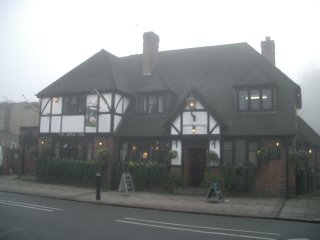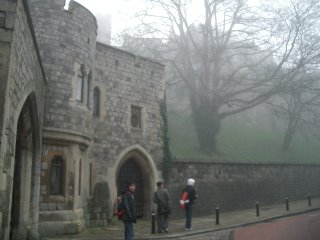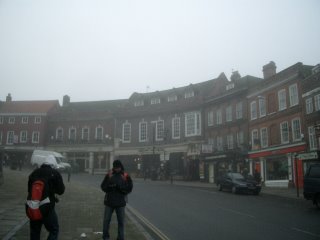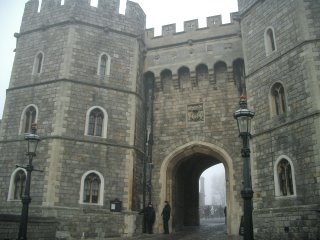
The tiny not so impressive train station at Windsor and Eton River! Cold!!!

The first building i saw once i stepped out of the train station. it looks victorian!

Up up up we go to the castle to catch the dragon!

The street up to windsor castle!

The exit of Windsor Castle! Nope, we haven't gone in yet!
by 11am we got off the train to a really foggy and freezing windsor! Windsor was really scenic being enveloped in green everywhere even though for our entire stay, it was shrouded in this heavy fog which brought along with it this chilling cold. we made a beeline to the castle which was just a 5 min walk from the train station. the walk there was really enjoyable and we quickly noticed that windsor is a quiet little town with few cars. the perfect getaway from the city if not for the cold!
once at the castle, we paid 12 pounds for our entrance fee (ouch!). at least this 12 pounds came with the audio tour!
off the pamphlet:
'Windsor Castle, the oldest and largest occupied castle in the world. Windsor is one of the official residences of Her Majesty The Queen.'
And 'large' it is indeed. we took a whopping 4 hours to walk through the grounds that were opened to the public! There is this mysterious feel to the castle, as i feel all castles should have since they date back to a really long time ago, and the fog really helped to enhance this atmosphere! the blurried outlines of the tops of the castle made it into many of the photographs i took!
Our first stop was the St George's Chapel. This was built in the 14th century by Edward III and the architecture was influenced by gothic designs. The pillars rose up to the high ceiling of the church and it was made to look as if the pillars sprouted from the ground all the way to the top. There were many chantries in the chapel. As taken from the st george's website, 'In the late middle ages, it became common practice for those who could afford it to create religious foundations called chantries. These foundations could take a wide variety of institutional forms, from altars or small chapels served by individual priests to great colleges such as St George's itself with a huge community.' Essentially, a chantry was a 'small church within a church'. There was this particular one that was highlighted on the audio tour. It was one that showcased a massive marble structure of the wife of one of the kings in the long history of monarchy in England. She passed away after giving birth to a stillborn child and her lifeless form was draped under a piece of cloth with only a bit of her hand showing and there were two mourners next to her bedside. Then above her body is a sculpture of her rising to the heavens, with two angels flanking her on both sides and one of them carried her stillborn infant. This sculpture was to provide relief to her bereaved family by showing that there is life after death. The amazing thing was that even though the entire structure was carved out of cold marble stone, the tapestry in the backdrop and the parts that were supposed to be cloth looked so realistic it is impossible for them to be made out of something as solid as stone! the sculptors were really skilful to have attained that effect!
The chapel housed the tombs of many of the kings and queens in the history of monarchy in England, including Henry VIII and the Queen Mother Elizabeth and her husband! i felt quite disrespectful walking on top of their tombs as some of the tombs were embedded in the ground where we walked on, with only a dark coloured slab of marble with golden writing of 'who-lies-beneath' which was integrated into the floor marking the area where they lie.
We then walked in the Choir (an area where the knights of the highest order of chivalry - the order of the garter, would take their specific places, during church service, together with the Sovereign and the Prince of Wales. Knighthood is really quite interesting and we met a castle warden, Morgan Campbell, who told us quite a bit about the history of knights. There are many different orders of knighthood, each on a different status level. For example, there can be the order of the British Empire, order of St Michael's, order of St George's. Individuals are knighted on the account that they have served the country in times of danger or have in any way served the country. Their achievements will be recognised by the Sovereign and they will personally be knighted by none other than the Queen herself. In the order of the garter, which is the highest order, there is the Sovereign (Queen Elizabeth II) and the Prince of Wales and 24 English Knights and Ladies. These knights have sworn in during their investiture to defend the sovereignty and the Sovereign will swear to defend the faith. Above every seat where the knight sits, there will be a flag bearing his coat of arms and there will be a crown with his own individual symbol and a half drawn sword. The half drawn sword symbolises the readiness of the knight to defend the sovereignty in times of need. there is an area just above the chair where a brass plague with the coat of arms belonging to the knight who sits there and the oldest brass plague dates back to the 14th century as these brass plates are never removed and they keep accumulating when a different knight sits on that chair. If there is no flag above the seat, it means the knight has passed away and has yet to be succeeded. Foreign diplomats, politicians or figures of high importance may also be knighted. They are known as 'stranger knights'. The emperor Hito of Japan was knighted and during the WWII, his flag bearing his coat of arms was removed for obvious reasons and slightly after the war, the Queen decided to restore the flag, much to the loud protests of Prince Phillip who was still in the Far East.
The frail old kindly warden Mr Campbell asked us where we were from and upon hearing my response, he exclaimed in mild surprise, 'ah... singa..ha..' it seemed to have stirred some old dusty memory in him.
'i've been to singapore. but at that time, the tallest building there was the parliarment house.'
'wow... that must have been a long time ago then!' we were unable to hide our shock.
'yes, that was back in 1945.'
you can't imagine how our jaws dropped. 'wait a minute, wasn't 1945 just slightly after WWII?!'
'i was serving in the airforce at that time as an engineer,' the shrunken 82 year old man smiled in amusement.
he is a piece of home. a piece of home found in a most unusual place. and a piece of home at a time when i wasn't even born. he is an alcove of history about this country i was born in. but i didn't dare to ask him any more questions in case i stirred up some sad memories. i mean a war is never a happy occasion. it's a pity he never went back to singapore. we didn't ask why. i guess a 13 hr flight is really too much for someone that old. or it may be some other reason. but it was truly an honour for me to meet a veteran. even though eventually britain didn't defend singapore from the invasion of japan, it was a dream come true for me to meet a war veteran even though i didn't have the guts to ask him more about the war. i have always wanted to meet a war veteran. There must be plenty in Britain. The next time i meet one, i'll be sure to ask him more about the war.
No comments:
Post a Comment